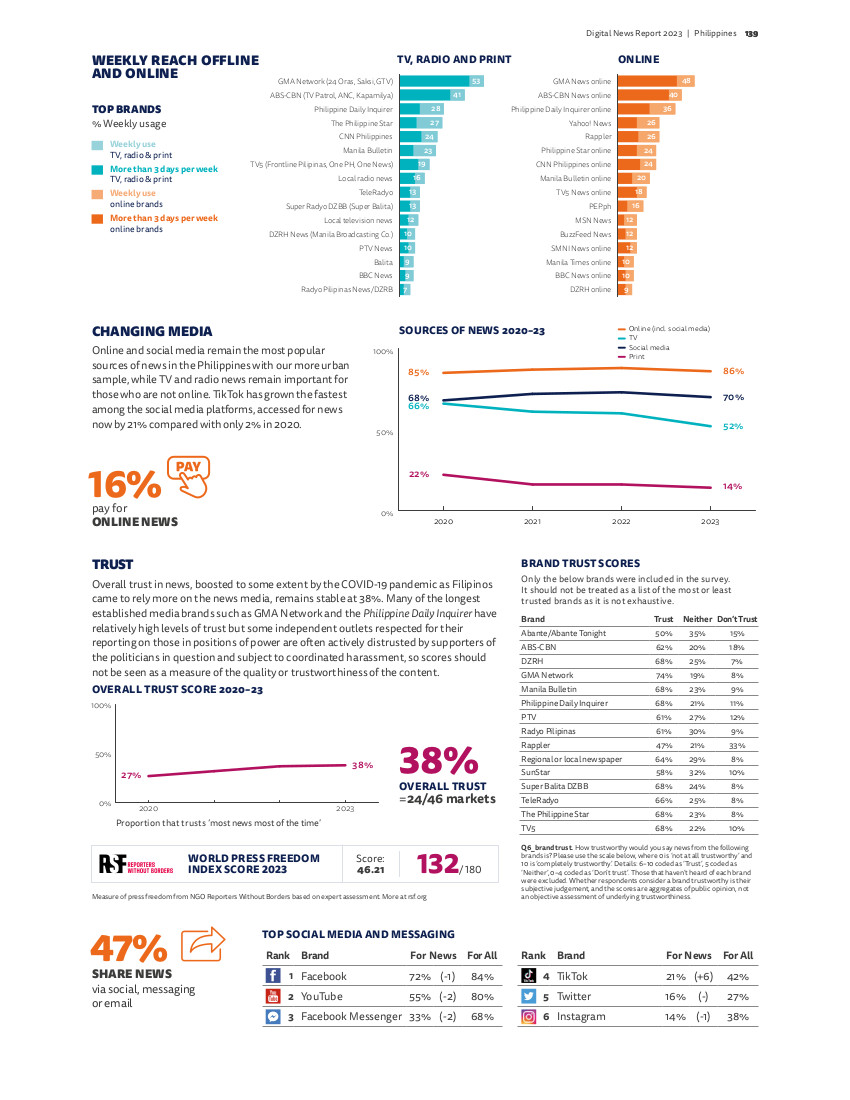The Philippine media landscape remains largely grim despite the change in the country’s leadership in mid-2022. Attacks on journalists, which escalated during the six-year presidency of Rodrigo Duterte, have not let up since Ferdinand Marcos Jr. took office.
Dozens of violations of press freedom have already been recorded under Marcos’s watch – 75 cases between June 2022 and April 2023 – topped by the killing of two hard-hitting radio commentators and increasing use of legal action (‘lawfare’) against journalists. A prominent critic of Duterte and Marcos, Percival Mabasa, was gunned down south of Manila in October, and soon afterwards death threats were sent to at least three journalists on social media. Police in plain clothes paid ‘surprise visits’ to homes of several reporters, stoking fears of surveillance of journalists.
‘Red-tagging’ of journalists – being branded as a communist or terrorist – persists. The targets come from mainstream and alternative media alike: journalists from ABS-CBN and GMA networks, Philippine Daily Inquirer, Rappler and Bulatlat news sites, the community paper Northern Dispatch, and representatives of media organisations such as the National Union of Journalists of the Philippines (NUJP).
Among those behind the systematic red-tagging is Sonshine Media Network International (SMNI), a far-right broadcast network owned by religious leader Apollo Quiboloy, wanted by the Federal Bureau of Investigation for sex trafficking and corruption charges. SMNI, which was awarded a free-to-air frequency that ABS-CBN had held till Congress rejected its franchise renewal application in 2020, is included in this year’s survey: 12% of respondents said they accessed online news from SMNI, demonstrating its popularity since the 2022 election despite having been flagged for peddling disinformation. The latest to join the network’s roster of commentators is Duterte himself who in January revived his weekly show Gikan sa Masa, Para sa Masa (From the Masses, For the Masses) days before the International Criminal Court announced the reopening of its investigation into possible ‘crimes against humanity’ arising from his brutal antidrug campaign. Duterte’s programme originally aired on ABS-CBN Davao from 2001 to 2015 when he was city mayor.
In response to the spike of cyber libel and other criminal cases against journalists, the NUJP teamed up with lawyers’ groups to launch Project Lawfare for their defence. As one example of the extent of these actions, two broadcasters in southern Luzon are facing 941 counts of cyber libel lodged by a provincial governor.
Rappler, which was repeatedly attacked by Duterte when he was president, and its CEO and Nobel laureate Maria Ressa were acquitted of tax evasion in January. But six months earlier, an appellate court upheld a decision convicting her and a former colleague of cyber libel and even increased their prison sentence, and public perception of the site is no doubt in part influenced by ongoing social media attacks from influencers, partisan activists, and others.
Radio and TV brands remain the most popular media overall in the Philippines, with the big GMA Network having a dominant audience share: 53% accessed it offline and 48% online. In February, the network began broadcasting morning news programmes in several regions, further boosting local TV news.
GMA’s longtime competitor, the Lopez owned ABS-CBN Corp., was stripped of its franchise in 2020 but continues to broadcast online and via various agreements. Its long-running nightly newscast, TV Patrol, simulcasts on its own cable channels as well as A2Z of the evangelical church-owned Zoe Broadcasting, and is now among the top 20 most-viewed TV programmes. But a multimillion-dollar deal with TV5 that was supposed to pave its return to free TV was terminated in September amid threats of lawmakers and the government to investigate it for possible violations of the law. Meanwhile ABS-CBN is closing its TeleRadyo news channel to stem further financial losses and will seek to distribute its content via new partnerships.
ALLTV, owned by business mogul and Duterte-Marcos ally Manuel Villar, debuted in September on the frequency once assigned to ABS-CBN. Instead of producing its own news programmes, it tied up with CNN Philippines to broadcast the recently revived hourlong News Night.
In answer to falling sales and rising costs of community publications impacted by economic downturn, inflation, and the pandemic, the Philippine Press Institute, an association of newspaper publishers, in October converted the PPI News Commons into a news aggregator with its 70 members on board, in hopes of leveraging the wider market base to attract ads. Last year, the Philippines became the first market in Southeast Asia to roll out Ads for News, a global effort that seeks to direct digital advertising to trustworthy local news outlets screened to exclude disinformation and other content unsuitable for brands. Three big Philippine corporations have initially agreed to take part in the programme.



